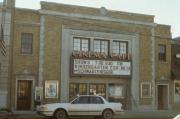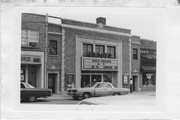| Additional Information: | A 'site file' exists for this property. It contains additional information such as correspondence, newspaper clippings, or historical information. It is a public record and may be viewed in person at the Wisconsin Historical Society, State Historic Preservation Office.
Locally designated landmark.
Architectural Description:
This two story Period Revival and quasi-Sullivanian styled brick-faced theater with Neo-Classical details is located on the south side of Main Street amidst commercial/retail buildings of approximately the same scale. Two stories high, with a large main entrance and two smaller side entrances, the theater blends well with the neighboring buildings. The windows on the second floor are all multi-paned. There are no openings other than the doors and box office on the main floor. The Neo Classical design elements-most notably the quoining, the central opening trim, the door hoods, and the scarab in the cornice-all appear to be cast concrete. Although the name has changed from the "Badger" to the Cinema Cafe, and the marque has been lost, the theater appears to have been changed relatively little since its construction. A newspaper article touted the building "as nearly fire-proof as it is possible to make one, its construction being of steel, brick cement and tile." [D]. The 1926 Sanborn shows a theater with a tile and brick faced front wall, plastered interior walls and a wood truss supporting the roof. [B]. Other construction elements of the theater include a rectangular shaped plan configuration, a brick, tile and concrete exterior, a tile and concrete trim, and a flat roof. The building is in good condition.
Architectural Significance:
The Badger Theatre is an example of Period Revival architecture with Neo-Classical details. It is the only downtown theater in Stoughton, and its design shows a last effort toward embellished architecture before Stoughton's lean years of the twenties and thirties.
Historical Background:
When it opened on March 26, 1921, this theater was known as the Badger Theatre. [D]. It was owned by Charles Guelson and Gustave Roe. Guelson appears to have been the active partner, as a newspaper article of 1929 says that while Roe is part owner of the theatre, he is "head of the Roe Auto Company and devotes his time to the automobile business." [D].
Guelson came to Stoughton in 1908 to work as a clothing salesman for the Department Company Store. He subsequently worked for the Melaas-Johnson company, purchased an electric shop, and sold automobiles for the Roe Auto company. In 1916, he bought out the Lyric theatre from Jacob Moelk. [D].
Roe was the son of prominent Stoughton citizen Ole K. Roe, who was active in the local tobacco business, and had been Mayor from 1896 to 1901. Along with his brother Carl, Gustave had been in the garage business since 1912. [C]. Guelson appears to have consistently tried new ventures, and probably enticed Roe to join the theater business while he was working for the Roe Auto Company.
In 1920, Guelson and Roe purchased and demolished the Beardsley house. [D]. The site was chosen for the natural slope of the land which accommodated with construction of a sloped floor for the desired seating. [D]. Construction for the theater began in April of 1920. It opened for business in March of 1921. The first "taklie" came to the theater in 1929. Full front page coverage by the Courier Hub was given to the event. [D]. The theater was called the Badger until sometime between 1979 and 1990, when the name was changed to the Cinema Cafe.
Stoughton's first moving picture theater, the Lyric, opened in 1908, and was located on Main Street. It was owned by Jacob Moelk, who also owned the later White Theatre on the corner of Main and Division Streets. The Globe Theatre (unknown location) and Princess Theatre (corner of Main and Water Streets) gave Stoughton a total of four theaters at one time. [D]. These movie houses were gone by November 1929 when the Badger opened the first talkie in town. Movies were also shown in the City Hall Auditorium beginning in 1910. A second story theater was also located in the Williams Block (also known as the First National Bank Building, demolished by fire), but it is unclear whether or not movies were shown there. [A].
Historical Significance:
This property is significant as an example of the entertainment/recreation industry in Stoughton. Ther is no other specialized theater building in the commercial downtown, where there was once four movie houses. With uninterrupted operation, the period of significance begins with construction in 1920 and extends to 1940.
August 2013: New marquee/awning, restored transom above front windows.
August 2019: Appearance unchanged. |
|---|
| Bibliographic References: | A. Samuelson, Bob. "Stoughton Theater Auditorium," Edgerton Reporter. May 26, 1987, p. 34.
B. Sanborn-Perris Insurance Maps: 1884, 1887, 1889, 1892, 1904, 1912, 1926, 1926-43.
C. "The Stoughton Courier-Hub." 18 March, 1928.
D. "The Stoughton Courier-Hub." 5 November, 1929.
E. W. H. Lightfoot Co.'s Dane County, Wis., Directory 1928-29. Peoria, Illinois: W. H. Lighfoot Co., 1928.
F. Rebecca Sample Bernstein for the City of Stoughton Landmarks Commission and Downtown Revitalization Association, Historic Main Street: An Architectural & Historical Guide to Downtown Stoughton, 1991. |
|---|


